What to look for when buying a used combine
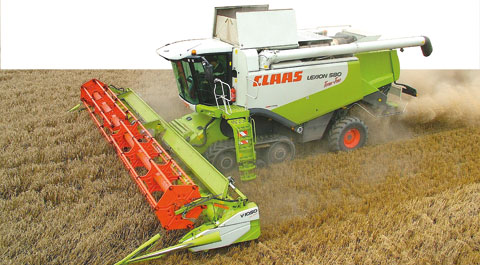
A combine is probably one of the largest long- term capital investments an arable farm can make, so while a second-hand machine can make an attractive alternative to new, it’s essential to ensure you’re not buying something that could be inefficient, expensive or unreliable.
Taking a little time to check through the finer details should mean you end up with a peach, and not a lemon.
Not only is a combine usually the most expensive machine on the farm, but it’s also probably the most complex.
It pays, therefore, to spend more than a little time examining potential purchases if buying second-hand.
Most dealers are likely to be offering machines that have undergone at least basic checks and servicing (if not a thorough overhaul), but machines being sold through private vendors may cover a far wider range of conditions.
Farmers Weekly and www.fwi.co.uk are both good sources for those seeking used machinery, but it’s hard to split the good and the bad from a few words and a photo.
Here, with the help of Gary Jackson of Kent Harvest Centre, we provide a few pointers to not only help the uninitiated, but also remind experienced buyers of the little things that can be overlooked when assessing a potential purchase.
We’ve used a three year old Claas Lexion 580+ as our case , but almost everything referred to here applies to all combine makes and models, whether conventional, hybridor rotary.
The state of a combine’s header can give a good idea of how well cared-for the machine itself has been.
While knocks ands crapes to guards can’t always be helped, the more important area is the cutterbar itself and the stone guards underneath.
Look for signs that it has worked on stony or flinty ground.
While a good operator will have taken care to account for this by keeping a careful eye on his cutting height, there may be evidence of stone ingestion further through the machine if this isn’t the case.
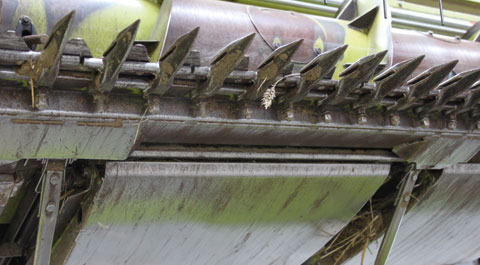
Cutterbars – and combines in general – are likely to have had slightly easier lives if they’re from marsh, fen or similarly stone-free soils.
Above the elevator, check that the drum door isn’t bent – another sure sign that the machine has been ingesting more than it should.
Check inside the elevator for dents caused by stones, and look for wear on the elevator chains and bars.
Check the cutterbar auger for dents, cracks and general damage – further evidence that a machine has had a hard life on stony ground.
See also that the reel bars are straight. Returning to the side of the header, open the guards and check for any stress cracks around the wobble box mount for the knife drive.
Also check the table auger slip clutch for signs of previous seizure and heating.
The heart of all straw walker and hybrid combines is the cylinder and concave, nowadays often complemented by a system of additional threshing drums/beaters.
Open up the side of the machine and examine the concave, drum and associated beaters etc. for damage.
If there is a problem, it’s also likely to be audibly evident when the drum is engaged.
Moving to the other side of the machine, open the opposite side panels and check all belt drives for evidence of stuck pulleys and burnt belts Ð particularly important is the drum drive belt.
Clear evidence of any serious seizures will be a blue-black discolouration of pulley steel caused by seizing/jamming and consequent overheating.
When checking the condition of the sieves, there are few alternatives to getting up into the back of the machine. Many modern combines have cable-anchored maintenance lights inside the straw hood, but it’s worth taking a torch with you just in case.
Check the sieve segments to ensure they are firm and tight, and look for any signs of cracking. Check the condition of the straw walker bearings and blocks for play, cracking and general damage.
The state they are in should be relative to the age of the combine and the amount of work that it has done, so beware if there are obvious issues.
If it’s a higher-output, non straw-walker machine that you’re looking to buy, the simpler nature of most designs means that there is less to look over in the threshing/separating area, but when the machine is in operation, make sure to check particularly for excessive noise Ð unusual whining Ð from the rotor drive gearbox.
Also check for oil leaks from gearboxes, which can be a particular issue if the machine has been used to cut a lot of harder-to-thresh crops such as linseed.
On both the clean grain and returns elevators, check generally for excessive wear, looking particularly at the paddles.
Also check auger edges, as these can become sharp with age/ wear, especially on combines that have been used to cut a lot of harder, more abrasive crops such as peas and maize.
It pays to get some idea of what a combine has been used to cut throughout its life, as in wear terms maize (for example) can wear a machine’s key components five times faster than wheat.
Raise the grain tank lid(s) – many are now electrically-operated, so check that this works as it should and that the lids are undamaged – and ensure that both the bubble-up (filling) and unloading augers are in good condition, with no sharp edges.
Once you are ready to run the machine, ensure the unloading auger works as it should, and shows no signs of external damage
.
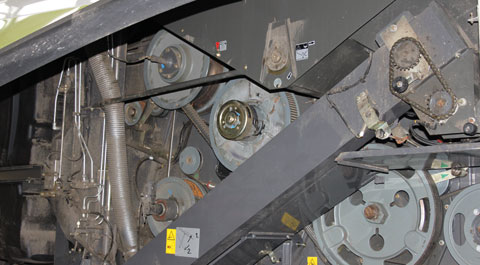
Check the condition of the straw chopper blades, and look for any signs of cracking around bearing mounts and housings.
Any evidence of stone damage at the top of the hood where the chopper has pinged them should be a warning sign of the damage stone ingestion may have caused throughout the machine.
When the engine is running and machine functions are being checked, engage the chopper and ensure that there are no issues with balance and that it runs smoothly, listening and feeling for vibrations.
Run the engine for 15-20 minutes to get it up to working temperature, and see that it operates smoothly and evenly, without smoking.
Once warm, engage all internal threshing components progressively until all are operating.
Listen for vibrations and evidence of bearing failures, operating the machine through its complete speed range. Problems are more likely to be evident at higher rpm.
After running the machine and engaging all the threshing components Ð with, ideally, the header coupled so that its functions can be checked Ð shut the engine off and look it over
Doing things this way round is more likely to reveal any evidence of problems Ð leaks etc.
Check oil level and colour, water level, air filter, and look for general evidence of proper servicing.
Ensure the chaff screen is in good condition, and see that there are no leaks from the radiators behind it. If oil or water leaks are evident, try and identify the source to give some idea of how big the repair job might be.
As with any self-propelled machine, the state of the cab interior is a good measure of the care that’s been taken in looking after the vehicle as a whole.
With a combine, upon opening the door beware particularly the scent of damp, and even mice.
Most modern machines, though, should have cabins that are well sealed from both.
With many machines now featuring a joystick and a single monitor/terminal in place of a number of different gauges and controls, these are probably the most important parts of the cab to look over.
When firing up the machine, allow the monitor to run through its start-up procedure, ensuring that it lights up correctly and no unexpected warning signs are displayed.
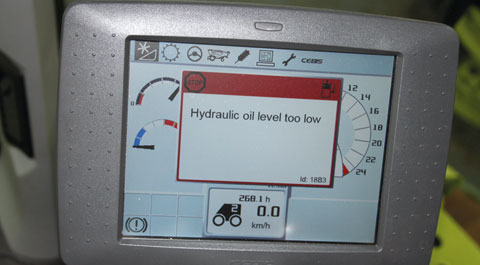
There are agricultural electronic specialists who can repair monitors with problems, with prices likely to start at around £300 for basic backlight issues.
Check the total acreage cut, engine hours, threshing hours and chopping hours for the machine to see how hard it has worked and whether this tallies with what you’ve been told about the combine’s history.
When you are ready to fire the machine up and check through its operating features, also ensure that the air conditioning is working correctly.
Over the past decade, the number of new combines offered/sold with mechanical transmissions has all but dwindled to nothing, and most used buyers are likely to be looking at a hydrostatic machine. Ensure that the transmission operates smoothly with no jerking when the lever is pushed or pulled, and that the ranges change smartly.
A hydrostatic transmission failure can mean a £10kbill, so if you’re in any doubt, seek advice, walk away, or budget accordingly.
If you are looking at a combine with mechanical transmission, it goes without saying that the clutch should be checked for play and engagement, and the combine worked in all gears.
While the majority of combines are still fitted with front wheels/ tyres, larger machines are commonly now equipped with tracks, and these need to be checked carefully, as damage can be expensive.
Ensure that the tracks run square ,as they can run off-centre if abused, especially if the steel bands within them have snapped.
This causes the track to lose tension and run unevenly.
Also make sure that tracks are not seriously cut or damaged, and that there is no wire poking out of the rubber.
Combine tracks are built for many years’ service, but if damaged, a new one will cost around £4,000 to supply and fit.
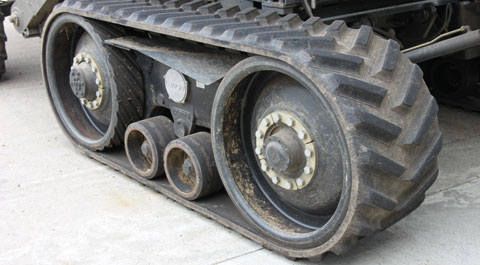
Check the drive wheels and idlers, but usually there shouldn’t be a problem here.
If the machine you’re looking at has front tyres rather than tracks, there may at first seem less to look over in this area, but as combines have become larger and heavier, it has become more and more important to check them over, as they are carrying ever larger loads.
As they and the machines they are attached to have become wider, and road-calming “islands” have become more commonplace, damage to sidewalls has become more of an issue, so check them carefully.
When you’re looking to buy a used or new combine, Farmers Weekly Classified is one of the best places to start.
We encourage our sellers to provide as much information as possible on their vehicles so that you can make the best choice possible.
With Farmers Weekly Classified you can search the largest online marketplaces for farm machinery and vehicles in the UK quickly and easily to help you get the best deal possible.
If you’re looking for more information on new combines or any other farm vehicles, our online resource Power Farming can help.
You can directly compare the details of vehicles with each other, allowing you to make a more informed choice.
There’s also the opportunity to get reviews from other farmers about what they think of the machines they work with.
